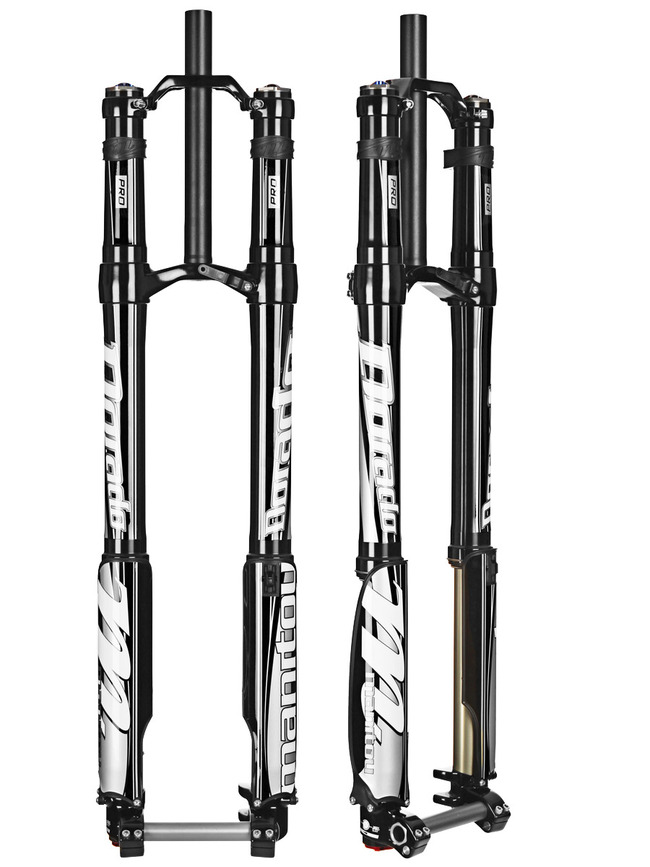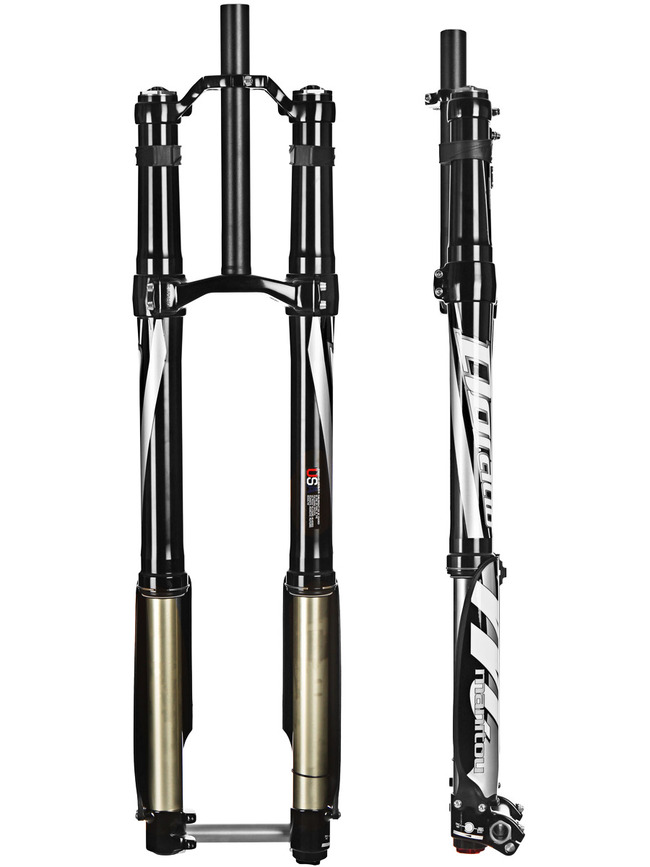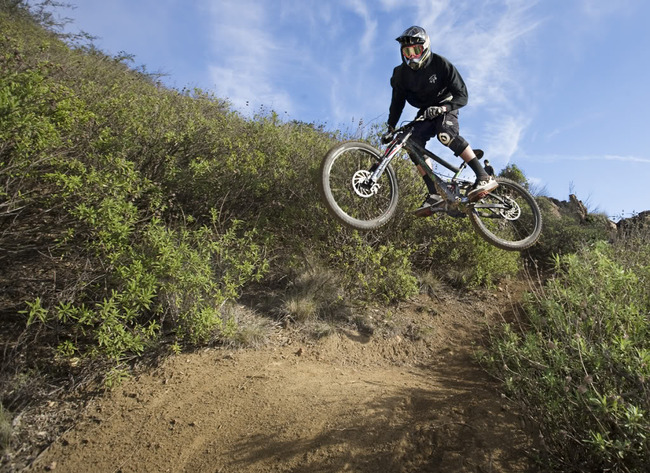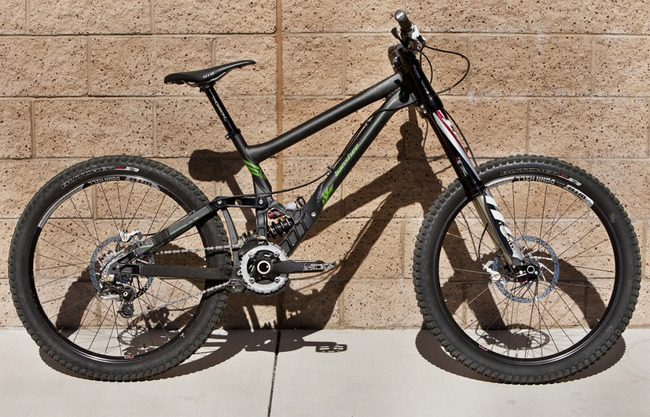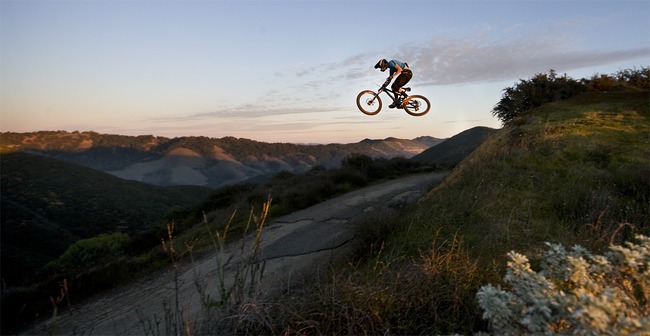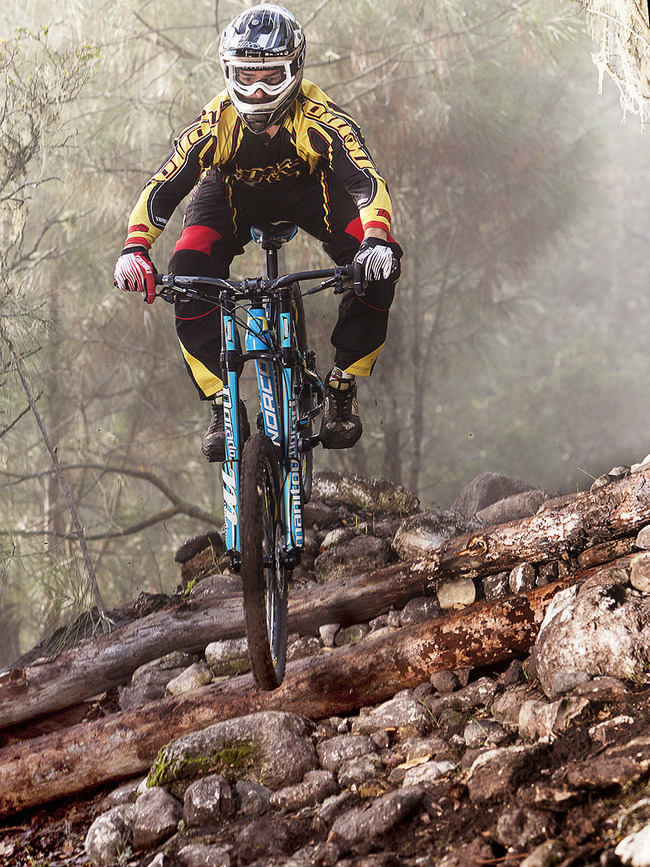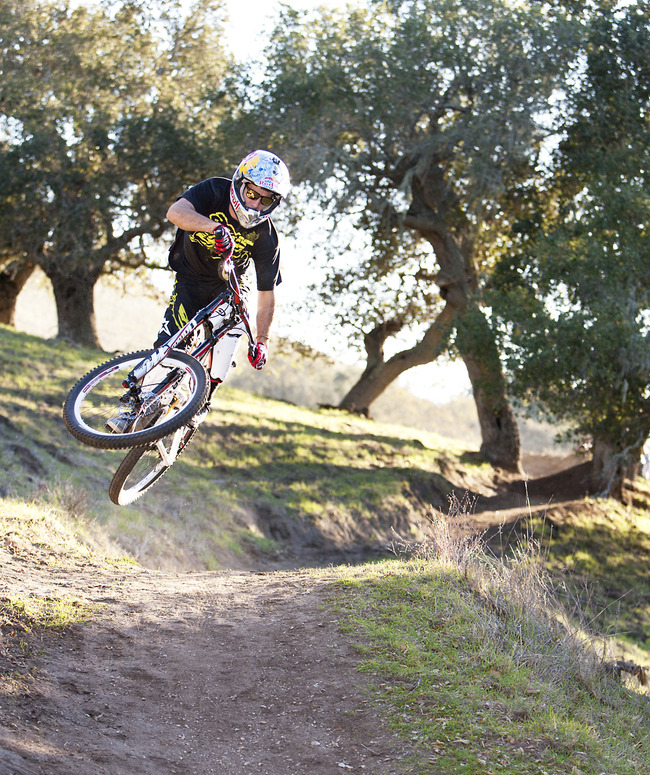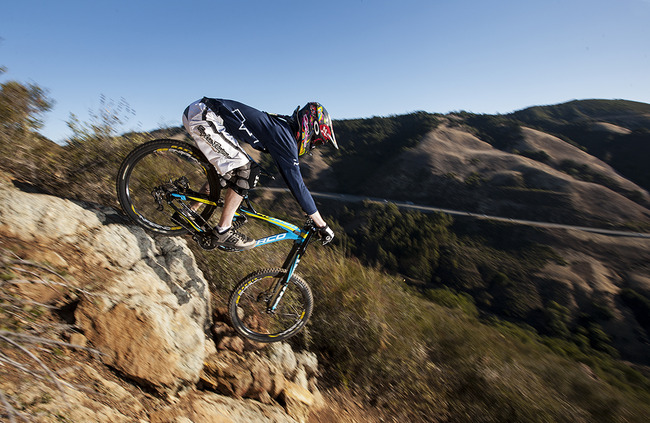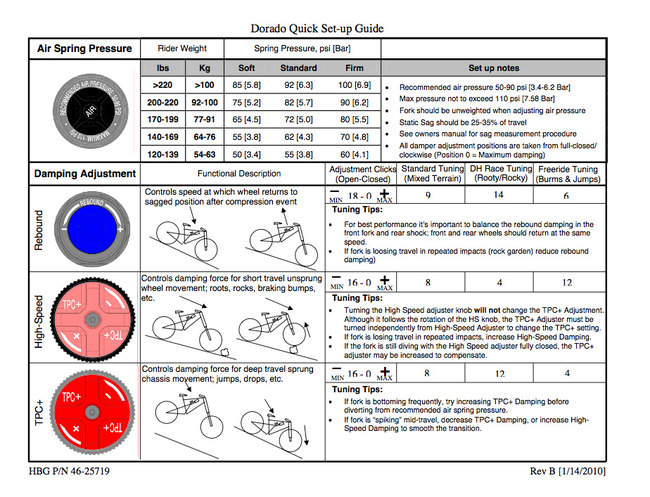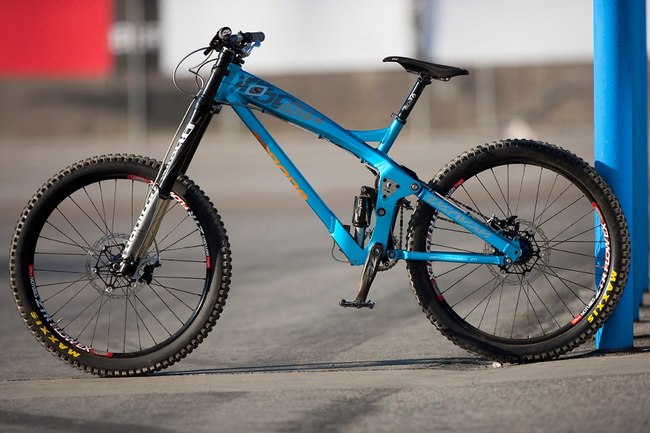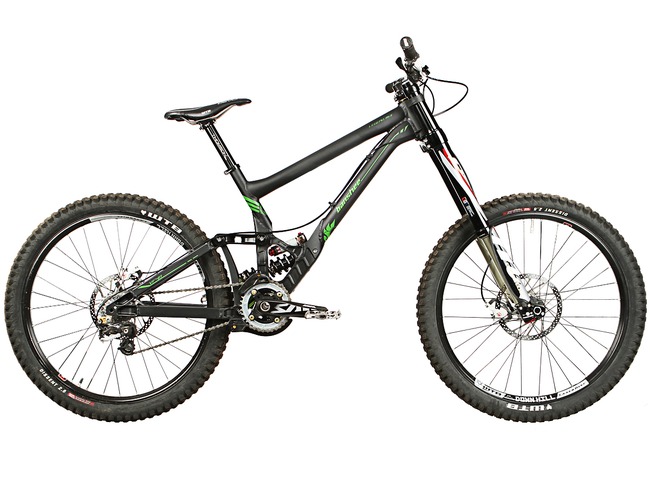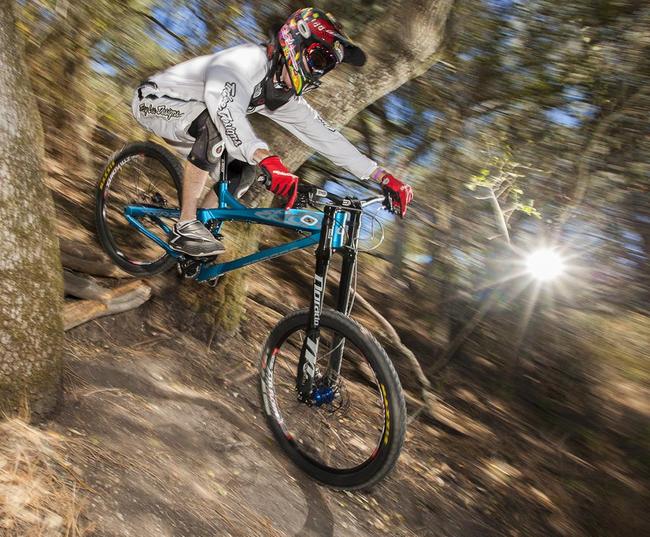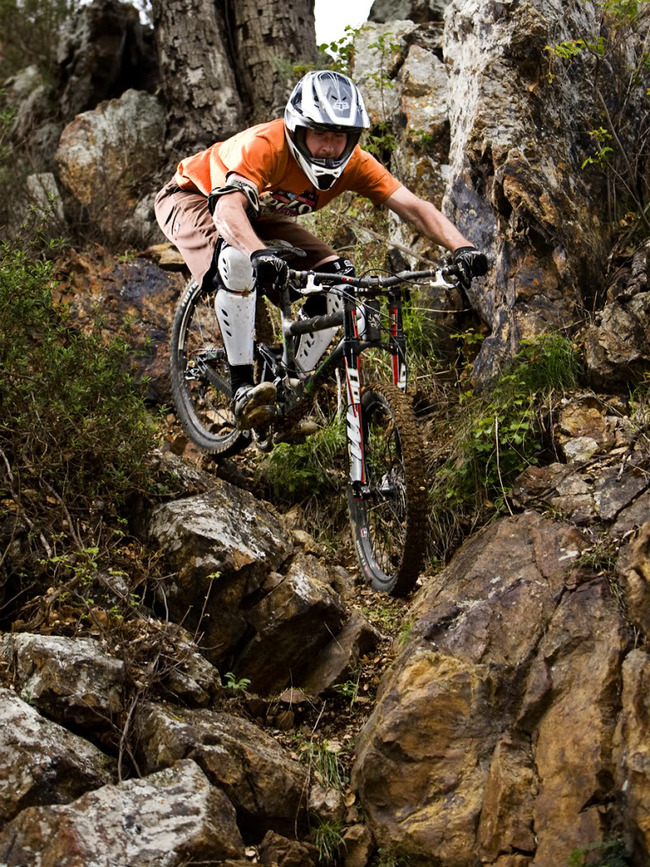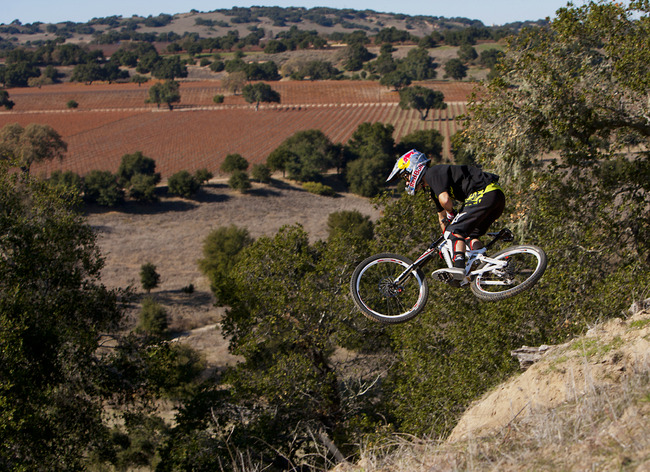Manitou Dorado Pro Review
 Sunday, July 14, 2013 at 8:28AM
Sunday, July 14, 2013 at 8:28AM  Permalink
Permalink Manitou has been in the suspension game since the early 1990's. Gone are the days of their rubber elastomer springs. Throughout the late 1990s and early 2000's Manitou had a strong showing in the downhill segment. The used TPC in both their XVERT fork which was a Carbon Fibre standard triple clamp fork and then in their venture into the inverted market with the original Dorado around 2001-2003 with 30mm stantions and generation 2 came out from 2004-2006 with 32mm stantions. That fork worked well then manitou decided they needed the use the SPV vavling they were licensing from Turner and along came the MRD Dorado X-Works. It turns out downhill was not the appropriate venue for SPV. Its price was high for the time and people were expecting everything from it. That was in 2004 and 9 years ago. But some people seem to never forget things.Their new fork is using TPC + but now has a Dual Air chamber.
Today they are using a Dual Chamber Air design inside their new Dorado. In 2010 Manitou announced the Dorado Pro after extensive testing of the carbon fibre MRD version. This was good because that CF Dorado was approaching the $3,000 mark so very few people had them. The new design is somewhat light at 6.5 LBS and as plush as a fork can get. Out of the box it feels very supple and it feels better than most forks do after their required break in periods!
The new Dorado Pro is an engineering masterpiece. 7050 legs, inverted construction, dual-chamber air spring, TPC+ damping (with independent high- and low-speed compression), hydraulic bottom-out and top-out, and Manitou’s patented HexLock 20mm thru-axle add up to the most advanced downhill fork ever.
Features
| Weight Lb / grams | 6.55 / 2973.7 |
| Travel | 180, 203 Internally Adj. (29'er 175mm) |
| Spring | Air |
| Spring Rate | n/a |
| Bottom Out | Hydraulic and Rubber Bumper |
| Steerer | 1 1/8" Aluminum |
| Crown | Forged Hollow-Oval Bore |
| Crown Finish | Black Ano Polished |
| Offset | 49.55 |
| Compression Damping | TPC+ |
| Rebound Damping | Adjustable TPC |
| Adjustments | Air Compression (High Speed and TPC+) Rebound |
| Leg Diameter | 36mm |
| Leg Material | 7050 Aluminum |
| Wheel Size | 26 / 29 |
| Brake | Post Mount |
| Brake | 20mm Hex TA |
| Crown to Axle | 567 / 591 |
| Colors | Black Ano |
Hex-lock Thru Axle
Our patented hex axle locks the lower legs in place, eliminating rotation around the axle. This provides unsurpassed stiffness in a burly, no-gimmick 20mm axle system. US Patent #6, 412, 803.
Semi-bath with Evil Genius Seals
Semi-bath lubrication and Evil Genius seals have proven to dramatically increase the durability and service life of our forks. High quality Evil Genius seals, originally developed for motorcycle suspension, decrease stiction and keep fluids inside the legs where they belong.
Dorado TPC+ 4-dimensional Compression Damping
- Velocity dependant circuit responds to the terrain
- Pressure dependant circuit flattens the bumps
- Energy dependant circuit activates on big hits while providing unmatched small bump sensitivity
- Position dependant circuit creates a bottomless feel
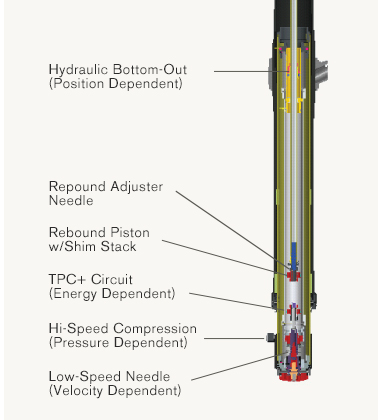
- Durability
- Traction
- Comfort
- Control
Original 2010 Press Release
"The Hayes Bicycle Group is pleased to announce the official release of the 2010 Manitou Dorado Pro.
The Dorado Pro features 7050 aluminum legs and utilizes the same premium internals as the Dorado MRD carbon version. With premium durability, the Dorado Pro maintains its World Cup DH race pedigree. However, it’s not a typical DH race fork anymore. With the added strength of the 7050 aluminum legs, it becomes a very capable park, free-ride and big mountain fork. Along with proven TPC+ damping, the fork has plush top-out coupled with a unique hydraulic bottoming ramp-up that makes the fork feel bottomless.
Updates for 2010 include an improved two-chamber, large-volume, low-pressure air spring which simplifies set-up and optimizes fork performance. The air spring pressure is now tuned by using a single valve at the top of the fork eliminating the second valve at the bottom of the leg. The pressure in the two chambers auto-equalizes when a shock pump is connected offering ease of set up by adding and/or bleeding off air from the top. Also, all mount hardware features high grade bolts with deep hex broaches offering an improved tool inter-face, and the brake line guide has been improved for optimum routing.
Spec:
- Weight: 6.55lbs
- Travel: 180mm/203mm for 26”
- 175mm for 29”
- Chassis: Alloy Legs & Crown
- Spring: Dual Air Chamber
- Damper: TPC+
- Hub: 20mm Hex Lock
The 2010 Dorado Pro was designed and tested in California and North Vancouver and is handmade in our Milwaukee, Wisconsin, facility. The Hayes Bicycle Group will continue to offer a one-year service program which allows riders to return their fork for factory service and inspection at no charge (specific rules apply to factory service). All race support at the HBG race truck will remain free of charge as we continue to support race teams, free riders and privateers. MSRP for the Dorado Pro in 26” is $1,749 and $1,799 for the 29er version."
We have gone through 4 or 5 Dorado forks now. The first one we had went on two different test bikes. Since then I have bought 4 others to build personal bikes with and demo bikes. I am known as a maintenance hack. My time is more valuable to me than spending a few hours rebuilding a fork every 4 weeks. Thats not gonna happen especially if I pay $1700 for the thing!
Our first test bike we built up with the Dorado Pro was the Canfield Jedi. Over the course of our 6 months of testing the fork preformed flawlessly. It mounted easily, has respectable weight, and you dont need suspesnion analysis software to dial the thing in. The Jedi got alot of vertical feet put on it and fast. In its first day out on the hill it had almost 25,000 feet ridden.
The Dorado felt perfect out of the box. Smooth as can be, the only other fork I can compare it to is a Shiver or old Monster T. There was no detectable stiction and the whole way through the fork just eats up chunky terrain like it is not even there. This is one of the areas it leaves other forks looking feable. Not only is it very small bump compliant but the air spring has a natural ramping effect making a bottom out on the Dorado a rare occurance and if it does happen the rubber and hydraulic bottom out control makes it a non issue.
As stated earlier maintenance is something I despise and having a fork blow a seal every month or needing a major overhaul is just way to much. That first Dorado we had was on 2 test bikes and easily eclipsed 300,000 vertical feet of hard decending on it. Never once in that time was the fork serviced! They suggest doing a service at regular intervals, it sort of slipped my mind and the fork ran great the whole time.
Towards the end of year two it was sent in for a complete rebuild and service. It was still under the service period so that was free. We have tested other complete bikes, one had a Boxxer WC and the other had a Fox 40 coil. Both of these developed seal leakage with 3 months of riding. The durability of the Dorado is simply amazing.
Setting up the Dorado was really very simple. In fact with the suggested set-up instructions Manitou includes it is pretty straight forward. We ended up using the DH Race tuning as a start point and then sped up Rebound and increased TPC + a few clicks. I weigh 209 and ran 90 PSI almost the entire time. Sometimes a little less depending on the trail.
Clicking the adjusters just one click is noticeable in the way the fork reacts on the trail. The fork has a fair bit of adjustment range to suite most users. Having the ability to fine tune the preload with the addition or removal of air in such small increments gives the Manitou Dorado Pro a distinct tuning advantage over a coil fork.
We rode the Dorado on rough chunky rock filled trails, down loose steep brake bump filled shoots and over smooth hero dirt up in Santa Cruz. The fork excelled everywhere it went. It provided traction over rough trails and as the speeds increased it had no problem keeping up and making the trail feel more like a sidwalk. The Dorado has the ability to keep low speed and high speed hits well in control without sacraficing one to make the other better. This is another area the fork excels at having a High and Low speed compression that truely seems independant of one another.
Also of note is the Norco Aurum 1 we tested came with the Manitou Dorado Expert. This is a lower dollar fork that is a bit heavier than the Pro version but internally it is identical. Manitou gained some weight and lowered cost by using a 6000 series aluminum, and forged triple clamps on the Expert. But riding the fork it feels just as plush and responsive. You can get the Expert brand new for about $1100 which is a pretty killer price!
We found a few negatives worth noting. The older Manitou Dorado came with two different top crowns one was flat and the other was a drop crown. They have since done away with the drop crown and now it comes with just the flat crown. That takes away some adjustment which may be a concern for some. Another issue that some of us noticed if paying attention you might notice that the fork is a little more flexible than a conventional fork. It is more noticeable going from a Fox 40 to the Dorado. I would say the Dorado has about the same amount of flex in it as a Boxxer WC does. Some people think this may be a benefit in its ability to track over rough terrain. Not sure but the fork really does shine on rougher trails.
Conclusion
Overall the Manitou Dorado Pro has proven to be an awesome fork. Its realibity, tuneability, responsiveness and dampening characteristic are something that none of us have experienced in any other fork. A fork is a very important piece of kit it controls the front wheel, where it goes how well it tracks the ground and how much traction the rider can get. There was never once while riding the Dorado over the last 3 years that I thought it could be mcuh better. In fact most of the time it worked and I forgot all about it being up there. I just knew it was doing its job up front. Point the bike where you want to go and the Dorado Pro will see that the front wheel gets up and over any obstacle in your way without much fuss. The hard part will be finding a rear suspension that can keep up with the fork! We would for sure recommend the Manitou Dorado Pro or Expert to any of our friends with the new Manitou Dorado line effectivly becoming the downhill fork to beat.
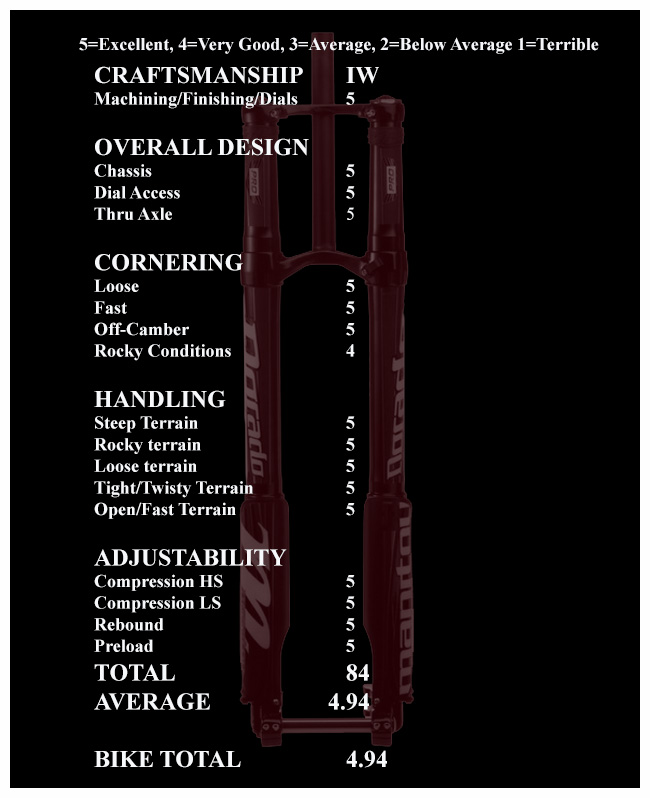
Manitou Answers Some Questions
1. Manitou has made 2 traditional and 3 inverted downhill forks since 1999 if I remember right? Is there a reason you decided upon inverted for your latest version?
Correct, Traditional: X-vert & Travis, Inverted: Gen 1/2/3 Dorado. There are advantages and disadvantages of each design. Inverted allows us to keep bushings constantly lubricated, increased bushing spacing vs. traditional for improved stiffness and reduced friction, the large diameter outer legs give us the stiffest chassis (fore-aft direction) which is the direction that the majority of loads are input into the fork. Disadvantages are increased weight, decreased torsional stiffness, and added cost. So the decision to go inverted was part performance advantage and part building on the Dorado legacy of years past.
2. What were the main objectives in creating the latest generation of Dorado?
The Dorado was designed to do one thing… race. Damping performance was the top design parameter when designing the Dorado. It had to react faster, track better, and maintain control throughout travel better than any other fork on the market.
3. One of your engineers came from Showa USA correct?
Yes, Ed Kwaterski came from Showa, but the Gen 3 Dorado MRD design began before he started with HBG. Ed and the experience he gained while at Showa is a great asset to the brand.
4. What do you think is more important in a fork reliability or weight?
Is performance an option? If you can make a 8lb fork react faster to the terrain and control the wheel and chassis better than a 6lb fork, isn’t it worth the additional weight?
5. Initially the Dorado was hand made here in the states that ended how has the QC and product been since?
In order to increase our Dorado volume and remain competitive with other brands we needed move the Dorado production line to our Taiwan facility with the rest of our product line. Like any other product that we begin production on, there is a great effort that goes into making every fork at the highest level of quality. But like anything else, there is a learning curve that goes along with a new product and we have not been without problems. Fortunately we have a very good Tech/Warranty and QC department that can react quickly to any quality issues and make sure we minimize issues in the field.
6. Your fork seems very easy to get a baseline setting and get out on the hill without too much fuss. Do you think with the current adjustability of suspension system it hurts or benefits the average rider?
DH riders are a special breed. They demand a high performance product, and it is our job not just to design and produce the product, but also to educate the user how to dial in their fork to their own riding style and terrain. The benefits of allowing the rider to fine tune their fork to specific course conditions is of the utmost importance. One weekend you may be racing a very technical course littered with rocks and slick roots. The next weekend you may be racing a flowing course with every turn burmed with a couple of doubles mixed in. You need your suspension to react for the specific conditions of the course, and that is where the adjustability of a fork comes in to play. All the adjusters can be overwhelming, but if we can provide good direction and the rider is willing to put the time into making the adjustments they will begin to understand the benefits of the system.
7. Rocks or turns?
Rocks
8. How beneficial is the Hex Axle versus a standard 20mm?
The hex shape on our axle prevents rotation of the axle under unbalanced torsion loads about the axle. The Hex Axle provide a solid interface between the drop-out and the axle that would otherwise slip under torsion loads. Without adding a good amount of weight to the chassis, we could not achieve the same level of torsional stiffness without the Hex Axle. A traditional fork has a casting arch to help fight torsional flex, but an inverted fork must rely on the axel and leg stiffness alone to resist torsional flex.
9. How quickly can you rebuild a Dorado?
Our tech boys have it down to about 1hr per rebuild.
10. Looks like the Pro GRT was won and Kevin is riding a Dorado that is cool. Any plans for more racers next year?
Always. The Teams & Riders we support are tremendous. They provide valuable feedback regarding our products and excellent exposure for our brands.
11. How do you feel about the current state of MTB suspension and the players involved? Do we have too many, too few, or too much marketing?
MTB suspension is just like any other market. Take the automotive market for example, some provide good value per dollar, some good looks, others good performance or weight. There are customers who value one of those characteristics more than others, but the majority are customers who value all. So generally you have to sacrifice one or the other characteristics to be competitive. Otherwise everybody would be commuting to work in a Ferrari. Unfortunately the performance of suspension is the most difficult attribute to quantify and advertise to the end user, you don’t really know if you really like it until you actually ride it. That is why reviews are so important; marketing creates brand visibility, but word of mouth is how we really win new customers.
12. Any plans for alterations coming in the near future for the Dorado?
We do have a few improvements in the works that will slowly trickle in over the next year, but we are not anticipating a full model year changeover anytime soon.
13. Where do you see the sport of Downhill mountain bike racing in 10 years?
Technology & Materials Advancement / Frame Development & Design will continue to push the DH Sport. This combined with: Improving Venues, evolving trail networks and powerful advocacy groups make for a bright future.
14. If I can convince The Tour De France to do an all drug race and then the next month an all natural event like bodybuilding which would you watch?
Who wouldn’t want to watch a guy who can squat 1200lbs on a road bike?
Dorado Pro Owners Manual





